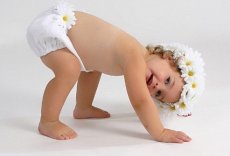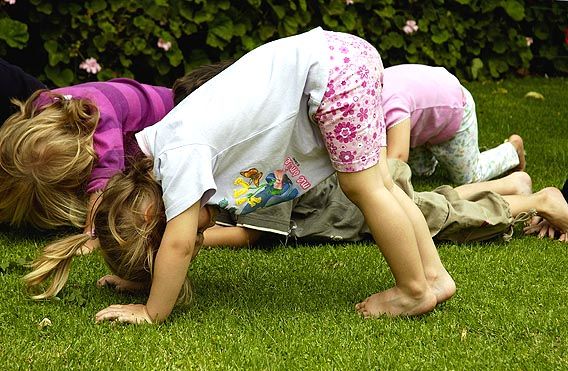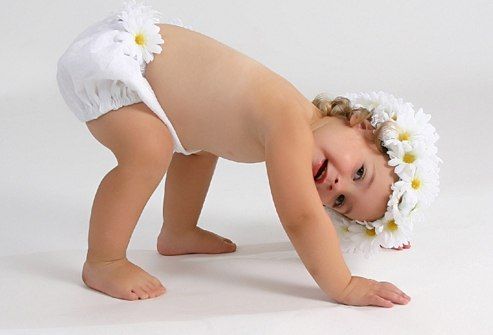Morning gymnastics for children 2-3 years old
Last reviewed: 19.10.2021

All iLive content is medically reviewed or fact checked to ensure as much factual accuracy as possible.
We have strict sourcing guidelines and only link to reputable media sites, academic research institutions and, whenever possible, medically peer reviewed studies. Note that the numbers in parentheses ([1], [2], etc.) are clickable links to these studies.
If you feel that any of our content is inaccurate, out-of-date, or otherwise questionable, please select it and press Ctrl + Enter.

Morning gymnastics for children of younger preschool age very well affects their growth and weight, as well as the formation of posture. Only hold it properly. The main thing is that the gymnastics for the kids should not exceed 10-15 minutes, and the exercises were simple and varied, so that the children were not bored.

Why do children need morning exercises?
Little children can not yet move in a coordinated way. Their motor skills are only being formed. Therefore, adults should give the child such exercises that will help strengthen the body and help develop coordination of movements. What is the difference between exercises and ordinary manual labor?
- Gymnastics develops those muscle groups that you have planned. You can focus on the development of a certain group of muscles.
- Gymnastics allows you to adjust the load in accordance with the health of the child and his interests in the exercises. For example, the same groupmates can be trained by charging with verses, gymnastics without the use of objects and with their application. Therefore, you can choose the appropriate group of exercises.
Before you begin to temper the child and teach him to the morning gymnastics, you need to take into account that some children have morning gymnastics is contraindicated. These are children who have a weak cardiovascular system, disorders in the functioning of the musculoskeletal system and general weakness, the causes of which are not established.
If a child performs morning exercises, he:
- Activates all body systems, including water-salt metabolism, energy metabolism, filling of blood with oxygen and nutrients
- The child strengthens all the muscles, which contributes to its better development and growth
- The child forms the correct posture, and this is a very important step, since the skeleton of a child is formed before the age of 13.
- The fact that the child performs rhythmic exercises, gives him the ability to properly adjust the breath. It is for the best work of the respiratory system that morning exercises for a child of 2-3 years should be conducted outdoors or in a well-ventilated room.
It is very important for children 2-3 years to keep to an average pace during the performance of morning exercises. The pace of exercise should increase and slow down gradually - you can not stop the exercise immediately. To finish the exercises you need this: first - running, then - fast walking, then - slow walking and finally you can gradually stop. Therefore, do not perform breathing exercises after running and fast walking - it will be a load on the heart and blood vessels, which is undesirable for a small child.
Groups of exercises for a child of 2-3 years
Children 2-3 years old during the morning exercises should be dressed in comfortable and loose clothes and in comfortable quality breathable shoes. This will allow clothes to absorb sweat secretions and at the same time the skin can breathe. Simple, but interesting exercises for children 2-3 years should be divided into at least three groups. These groups are designed to strengthen the different muscles and parts of the child's spine. Exercises should be simple, otherwise the child will not be able to fulfill them and quickly lose interest in the morning exercises.
The first group of exercises
To strengthen the shoulder girdle and arm muscles, straighten the upper spine, form a correct posture and correct breathing.
- We go in the direction that we like, then we go on the spot, then turn around. The starting position is to place the legs on the width of the shoulders, the handles to lower along the trunk. Hands up-then lower, and so do 4 times.
- The starting position - put the legs wider than the shoulders, lower the knobs. In this position, tilt forward so that the fingers touch the floor - then straighten up. So do 4 times.
- The starting position - which is convenient for the child. So, you can jump. Jumping can be 6-8, it's very uplifting to the child. Then you need to walk around so that your breathing calms down. So we finish the first group of exercises for a child of 2-3 years.
The second group of exercises
It is designed for flexibility of the bone system, in particular, the spinal column, strengthening of the dorsal muscles. The starting position while sitting with crossed legs (or straightened). When the child does the exercises, the knees should not bend.
- Walking in the direction that most likes the child, then walking in place, then turning to an adult.
- The starting position is slightly spaced legs, handles along the body. It is necessary to stretch the handles upwards, stretch properly, then lower the handles. This exercise should be repeated 4 times.
- The legs are wider than the shoulders, and the arms are lowered along the body. In this position, you must tilt forward, palm on your knees. This is very fun kids. The exercise can be repeated up to 5 times.
- The legs are not very wide apart, but the handles are below, along the body. Crouching squats - hands on his knees. And straighten up. The exercise can be repeated up to 5 times. To calm your breathing, you need to be a little bit like a place.
The third group of exercises

It is designed to strengthen the abdominal press, develop the ankle muscles, to form the flexibility of the arch of the foot.
- The starting position for these exercises is standing and keeping your back straight, and during the squats you do not need to remove the heels from the floor.
- You need to walk in different directions, then go for easy running, make a pair of mugs, and then go on walking on the spot. Then you can turn to an adult face, approach the chair.
- The starting position - legs to arrange, handles along the body, the child stands next to the chair. Bend over to the chair, lean on it with your hands, swing back and forth. In this case, you can say "tick-like", like an hour. Exercise can be repeated 4-5 times.
- The starting position is to sit on a high chair, legs to put parallel to each other, hands to put on knees. We lean forward - arms bend in the elbows - we turn our heads to the left and to the right, as if we are looking into the window. Then straighten up. The exercise can be repeated 4 times.
- The starting position is an arbitrary posture. Then - jumps in place, which are repeated 6-8 times. The exercise can alternate with walking on the spot.
Morning gymnastics for children 2-3 years is a very simple, but very useful tool to strengthen the child's body, to cheer him up and train him to organize.

